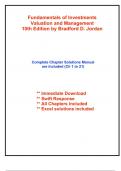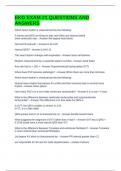Fundamentals of Investments
Valuation and Management
10th Edition by Bradford D. Jordan
Complete Chapter Solutions Manual
are included (Ch 1 to 21)
** Immediate Download
** Swift Response
** All Chapters included
** Excel solutions included
, Chapter 1
A Brief History of Risk and Return
Concept Questions
1. For both risk and return, increasing order is b, c, a, d. On average, the higher the risk of an investment,
the higher is its expected return.
2. Since the price didn’t change, the capital gains yield was zero. If the total return was four percent, then
the dividend yield must be four percent.
3. It is impossible to lose more than –100 percent of your investment. Therefore, return distributions are
cut off on the lower tail at –100 percent; if returns were truly normally distributed, you could lose
much more.
4. To calculate an arithmetic return, you sum the returns and divide by the number of returns. As such,
arithmetic returns do not account for the effects of compounding (and, in particular, the effect of
volatility). Geometric returns do account for the effects of compounding and for changes in the base
used for each year’s calculation of returns. As an investor, the more important return of an asset is the
geometric return.
5. Blume’s formula uses the arithmetic and geometric returns along with the number of observations to
approximate a holding period return. When predicting a holding period return, the arithmetic return
will tend to be too high and the geometric return will tend to be too low. Blume’s formula adjusts these
returns for different holding period expected returns.
6. T-bill rates were highest in the early eighties since inflation at the time was relatively high. As we
discuss in our chapter on interest rates, rates on T-bills will almost always be slightly higher than the
expected rate of inflation.
7. Risk premiums are about the same regardless of whether we account for inflation. The reason is that
risk premiums are the difference between two returns, so inflation essentially nets out.
8. Returns, risk premiums, and volatility would all be lower than we estimated because aftertax returns
are smaller than pretax returns.
9. We have seen that T-bills barely kept up with inflation before taxes. After taxes, investors in T-bills
actually lost ground (assuming anything other than a very low tax rate). Thus, an all T-bill strategy
will probably lose money in real dollars for a taxable investor.
10. It is important not to lose sight of the fact that the results we have discussed cover over 80 years, well
beyond the investing lifetime for most of us. There have been extended periods during which small
stocks have done terribly. Thus, one reason most investors will choose not to pursue a 100 percent
stock (particularly small-cap stocks) strategy is that many investors have relatively short horizons, and
high volatility investments may be very inappropriate in such cases. There are other reasons, but we
will defer discussion of these to later chapters.
,Solutions to Questions and Problems
NOTE: All end of chapter problems were solved using a spreadsheet. Many problems require multiple
steps. Due to space and readability constraints, when these intermediate steps are included in this solutions
manual, rounding may appear to have occurred. However, the final answer for each problem is found
without rounding during any step in the problem.
Core Questions
1. Total dollar return = 100($41 – $37 + $.28) = $428.00
Whether you choose to sell the stock does not affect the gain or loss for the year; your stock is worth
what it would bring if you sold it. Whether you choose to do so or not is irrelevant (ignoring
commissions and taxes).
2. Capital gains yield
= ( $41 – $37 ) / $37 .1081, or 10.81%
=
Dividend
= yield $.28
= / $37 .0076, or .76%
Total rate of return = 10.81% + .76% = 11.57%
3. Dollar return = 500($34 – $37 + $.28) = –$1,360
Capital gains yield
= ( $34 – $37 ) / $37 – .0811, or – 8.11%
=
Dividend
= yield $.28
= / $37 .0076, or .76%
Total rate of return = –8.11% + .76% = –7.35%
4.
a. average return = 6.0%, average risk premium = 2.7%
b. average return = 3.3%, average risk premium = 0%
c. average return = 12.3%, average risk premium = 9.0%
d. average return = 16.3%, average risk premium = 13.0%
5. Cherry average return = (17% + 11% – 2% + 3% + 14% ) / 5 = 8.60%
Straw average return= (16% + 18% – 6% + 1% + 22% ) / 5 = 10.20%
6. Cherry: R A = 8.60%
(.17 – .086 ) + (.11 – .086 ) + ( –.02 – .086 ) + (.03 – .086 ) + (.14 – .086 ) =
2 2 2 2 2
Var
= .00623
(.00623)
1/2
Standard=
deviation = .0789, or 7.89%
Straw: R B = 10.20%
= 1/ 4 (.16 – .102 ) + (.18 – .102 ) + ( –.06 – .102 ) + (.01 – .102 ) + (.22 – .102 ) = .01452
2 2 2 2 2
Var
(.01452 )
1/2
Standard=
deviation = .1205, or 12.05%
7. The capital gains yield is ( $59 – $65 ) / $65 = – .0923 , or –9.23% (notice the negative sign). With
a dividend yield of 1.2 percent, the total return is –8.03%.
, (1/5)
8. Geometric return =(1 + .17 )(1 + .11)(1 − .02 )(1 + .03)(1 + .14 ) – 1 = .0837, or 8.37%
9. Arithmetic return = (.21 + .12 + .07 – .13 – .04 + .26 ) / 6 = .0817, or 8.17%
(1/ 6 )
Geometric return = (1 + .21)(1 + .12 )(1 + .07 )(1 – .13)(1 – .04 )(1 + .26 ) – 1 =
.0730, or 7.30%





